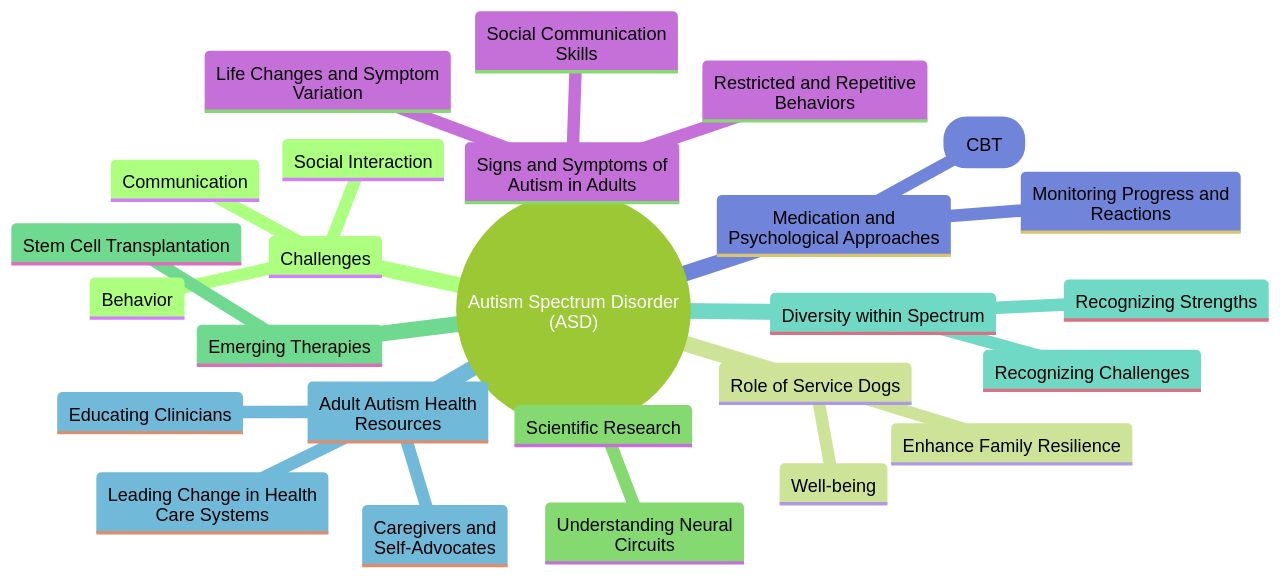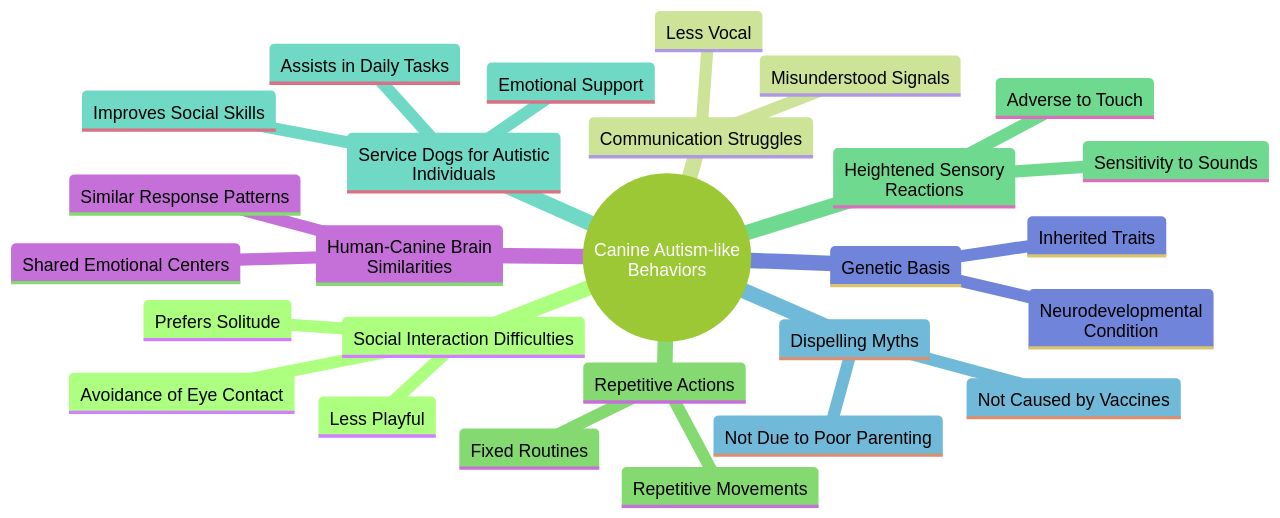Introduction
Autism Spectrum Disorder (ASD) is a complex condition that presents challenges in communication, social interaction, and behavior. In a recent study published in Frontiers of Psychiatry, researchers explored the experiences of families with children on the autism spectrum and discovered the profound impact that service dogs have on their well-being. These dogs not only assist the child but also enhance the family's resilience, fostering improved emotional well-being and interactions.
By strengthening social connections and reducing stigma, service dogs serve as a unique intervention for families facing the challenges of autism. Additionally, ongoing scientific inquiries are uncovering new insights into the neural circuits of the brain and the potential of emerging therapies, such as stem cell transplantation, in reducing inflammation associated with ASD. As we deepen our understanding of autism, it is crucial to recognize the diverse challenges and strengths within the spectrum and provide support and resources for individuals and their families.
What is Autism?
Autism Spectrum Disorder (ASD) is a complex condition marked by a myriad of challenges in communication, social interaction, and behavior, often manifesting as repetitive patterns and difficulties with both verbal and nonverbal communication. A profound study led by Dr. Maggie O'Haire's lab, published in Frontiers of Psychiatry, delved into the experiences of families with children on the autism spectrum.
By focusing on service dog placements, the research unveiled that these dogs do more than assist the child; they enhance the family's resilience, fostering improved emotional well-being and interactions, and becoming a source of joy and a family member in their own right. The study's qualitative approach revealed that service dogs serve as a unique intervention, strengthening social connections and reducing the stigma and judgment families often face.
Moreover, recent scientific inquiries, such as those by Professor Kenkichi Takase and Professor Eiichi Nojiri, are shedding light on the intricacies of the brain's neural circuits, emphasizing the significance of dopamine and serotonin in development. These findings not only contribute to our understanding of ASD but also underscore the potential of emerging therapies, including stem cell transplantation, which has shown encouraging results in reducing inflammation associated with ASD. The ongoing research, which integrates human brain transcriptome analysis and animal models, is pivotal in identifying new therapeutic targets for autism treatment. As we continue to deepen our understanding of ASD, it is essential to recognize the diverse challenges and strengths inherent in the spectrum, debunking myths and acknowledging that each individual with autism is unique.

Common Signs of Autism
Understanding the nuances of autism is essential for providing timely support. Dogs, like humans, can exhibit a variety of behaviors that may be indicative of autism. These behaviors can range from difficulties in social interaction, where a dog might show less interest in other dogs or people, to struggles with communication, where a dog may not respond to its name or commands as expected.
Repetitive actions, such as excessive licking or tail chasing, can also be signs, along with heightened reactions to sensory stimuli, which might manifest as a dog being easily startled by sounds or textures. Furthermore, dogs may develop intense, specific interests, such as a fixation on certain toys or routines. Research, including a groundbreaking study from the University of Arizona's O'HARE Group, underscores the profound impact that service dogs can have on autistic individuals and their families.
These dogs not only offer companionship but also enhance social connections and emotional well-being, contributing to the resilience of the entire family unit. This highlights the importance of recognizing and accommodating the diverse needs of dogs that may display autism-like behaviors, as they too can play a significant role in supporting autistic individuals. It's important to dispel myths surrounding autism.
Contrary to misinformation, autism is not caused by vaccines, parenting styles, or nutrition, but is believed to have a genetic basis. Although the exact trigger for autism's development remains unidentified, understanding the condition in both humans and animals is crucial for fostering supportive environments. As we continue to explore the mental landscapes of dogs, we gain insights into their ability to comprehend our world and the shared elements between our brains and theirs, which could further inform how we assist both canines and humans with autism.

The Importance of Early Diagnosis
Detecting autism early in a child's life is pivotal for their long-term development. With an early diagnosis, families can connect with vital early intervention services.
These services are tailored to address the unique challenges of autism spectrum disorder (ASD), which is characterized by social, communication, and behavioral differences. Interventions are most effective when they are intensive, involve family participation, and aim for skills that can be generalized to various settings.
Despite a consensus on these aspects, there is a gap in research comparing the multitude of intervention strategies available, particularly for the critical birth to 3-year-old age group. Routine health check-ups are now designed to include screening for ASD, with some children as young as 12-14 months being identified thanks to concerted efforts by institutions like the National Institute of Mental Health.
This is a significant step forward, considering the American Academy of Pediatrics recommends autism screening at 18 and 24 months. Yet, the CDC reports that the average age of diagnosis is still under 4.5 years.
Recognizing the signs of autism early—such as difficulties in understanding social cues, or exhibiting repetitive behaviors—can change the trajectory of a child's life. Research indicates that early intervention can lead to better outcomes, as young children's brains have more plasticity, adapting more readily to treatment. Moreover, disparities exist in the availability and awareness of autism services, particularly affecting black, Latino, and low-income families. These groups report more severe cases of autism and have less access to healthcare services. Addressing these disparities is essential, and implementing universal screening programs, especially those targeting underserved communities, can help ensure all children with autism receive the support they need to thrive.

Seeking Professional Evaluation
Recognizing the potential signs of autism in canines is a critical step in providing the appropriate support they need. For pet owners who observe unusual behaviors or developmental challenges in their dogs, it is imperative to consult with a specialist.
These professionals conduct thorough evaluations that include tracking developmental milestones, examining social skills and communication abilities, and observing behavioral patterns. Recent studies have emphasized the profound impact that service dogs have on the lives of individuals with autism, enhancing social connections and reducing the stigma experienced by families.
For instance, a partnership between Canine Companions and researchers from the OHAIRE Group at the University of Arizona College of Veterinary Medicine has yielded promising results, indicating that service dogs serve as a unique and individualized intervention, benefiting the entire family unit. This research, published in Frontiers of Psychiatry, reflects a growing recognition of the importance of mental health and the valuable role that assistance dogs play in fostering resilience and emotional well-being within families. As the demand for autism assistance dogs increases, it's clear that these animals are more than just pets; they are integral to the health and happiness of those they serve.

Next Steps After Diagnosis
Navigating the journey of autism requires a blend of understanding, advocacy, and actionable strategies. Recognizing the inherent strengths and challenges that come with autism is crucial.
It's not just about a diagnosis; it's about understanding a person's unique perspective and abilities. Empirical evidence supports the efficacy of certain intervention strategies, particularly emphasizing the importance of early intervention, family involvement, and generalizing skills to various settings.
It's essential to acknowledge that while programs exist for young children with autism, there is a diversity in approach and accessibility. The Autism Community in Action (TACA) reminds us that therapies can significantly enhance communication, social interactions, sensory processing, and independence.
With the prevalence of autism rising to 1 in every 36 children, early detection and services become even more critical, as children diagnosed by age 4 are fifty times more likely to receive vital support. Telehealth has emerged as a valuable tool for those who may not have immediate access to autism specialists, ensuring that no one is left without the help they need. Additionally, the language we use to talk about autism is evolving to be more inclusive and reflective of the autistic community's priorities. As we move forward, the clinician-caregiver partnership remains a cornerstone of effective care, empowering caregivers to be active participants in the medical team. With a focus on individual strengths and a willingness to adapt, we can create a supportive environment that fosters growth and well-being for those on the autism spectrum.

Conclusion
In conclusion, service dogs have a profound impact on the well-being of children and families dealing with Autism Spectrum Disorder (ASD). They not only assist the child but also enhance the family's resilience, fostering improved emotional well-being and interactions.
By strengthening social connections and reducing stigma, service dogs serve as a unique intervention for families facing the challenges of autism. Ongoing scientific inquiries into the neural circuits of the brain and emerging therapies like stem cell transplantation offer hope for reducing inflammation associated with ASD.
Early detection and diagnosis are crucial for accessing vital early intervention services tailored to the needs of children with autism. Routine health check-ups now include screening for ASD, but disparities in availability and awareness of services still need to be addressed, particularly in underserved communities.
Recognizing potential signs of autism in canines is also important, and consulting specialists who can conduct thorough evaluations ensures appropriate support for dogs exhibiting unusual behaviors or developmental challenges. Navigating the journey of autism requires understanding, advocacy, and actionable strategies.
Emphasizing early intervention, family involvement, and generalizing skills across settings is essential. Telehealth has emerged as a valuable tool for those lacking immediate access to specialists. Creating a supportive environment that fosters growth and well-being for individuals on the autism spectrum remains a priority. The clinician-caregiver partnership empowers caregivers to be active participants in their child's medical team. By focusing on individual strengths and adapting as needed, we can ensure that every individual with autism receives the support they need to thrive.




